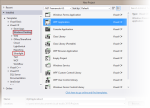Step 1 of 5: Creating a C1Menu Application
In This Topic
Complete the following steps:
- In Visual Studio, select File | New Project.
- In the New Project dialog box, select either Windows Desktop or Silverlight from the Templates in the left-hand pane.

New Project Dialog Box
-
- Select Silverlight Application and enter a Name for your project, for example "QuickStart". Click OK. The New Silverlight Application dialog box will appear.
- Click OK to accept default settings. This will close the New Silverlight Application dialog box and create your project.
- The MainPage.xaml file should open.
- Add the following assemblies to your application by right-clicking the References folder and selecting Add Reference:
- Silverlight: C1.Silverlight.5.dll
- Navigate to the Visual Studio Toolbox and add a C1Menu control by double-clicking.
- Edit the control's markup to add Height= "Auto" and Width= "Auto" to the <c1:C1Menu> tag. It should resemble the following:
| XAML |
Copy Code
|
<c1:C1Menu HorizontalAlignment="Left" VerticalAlignment="Top" Height="Auto" Width="Auto"/>
|
You have completed the first step of the Menu and ContextMenu for Silverlight quick start. In this step, you created a project and added a C1Menu control to it. In the next step, you will add top-level menu items to the control.